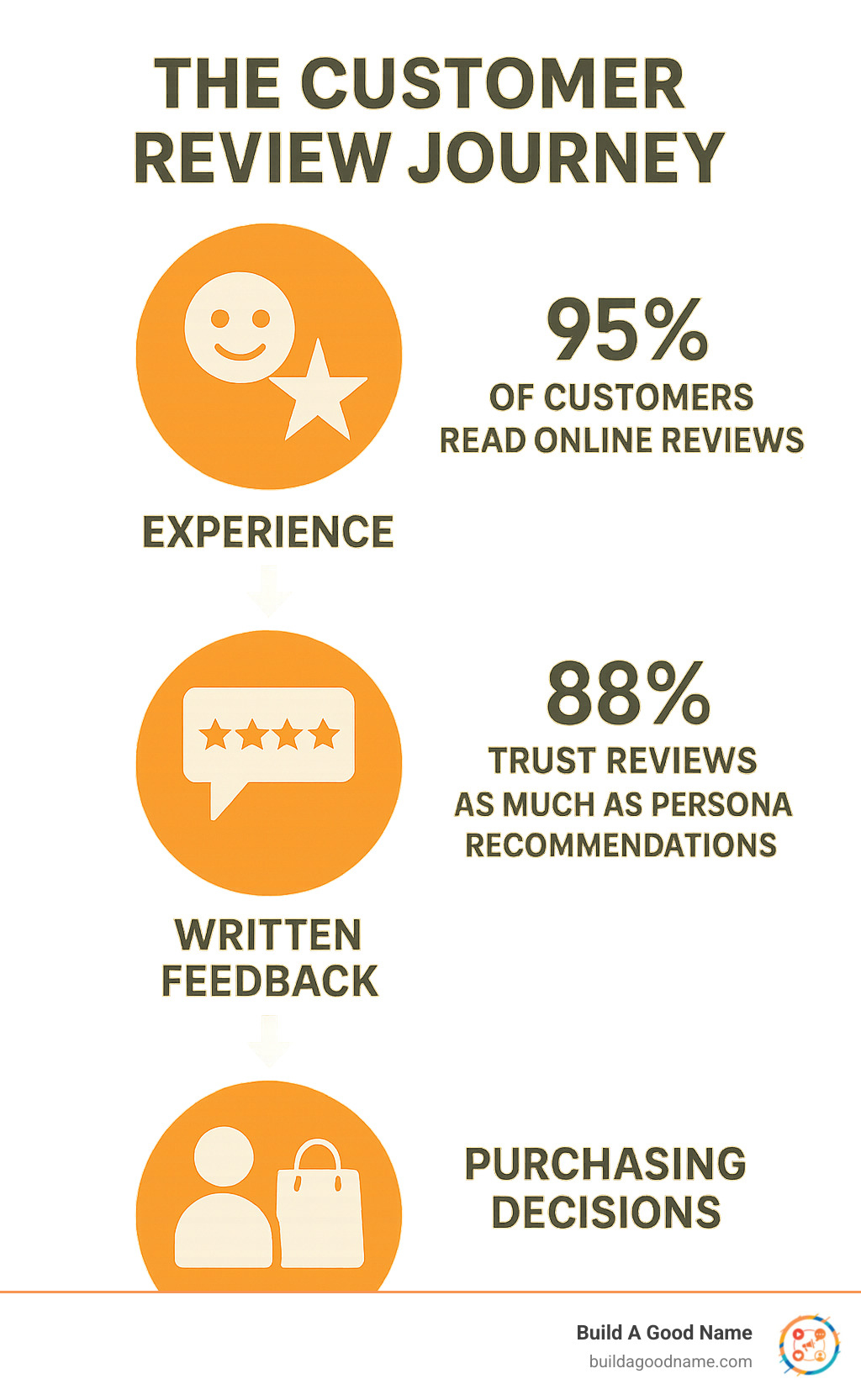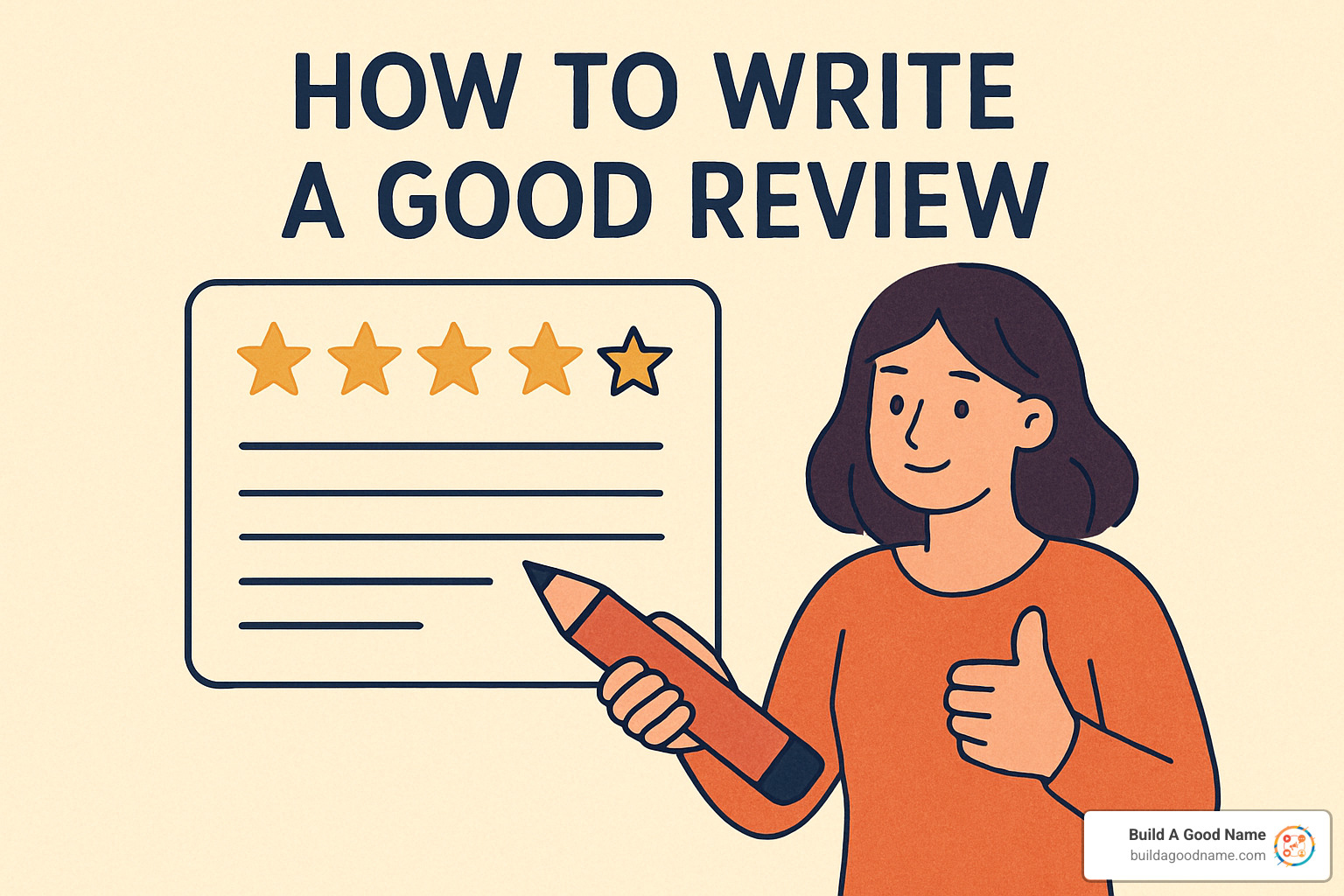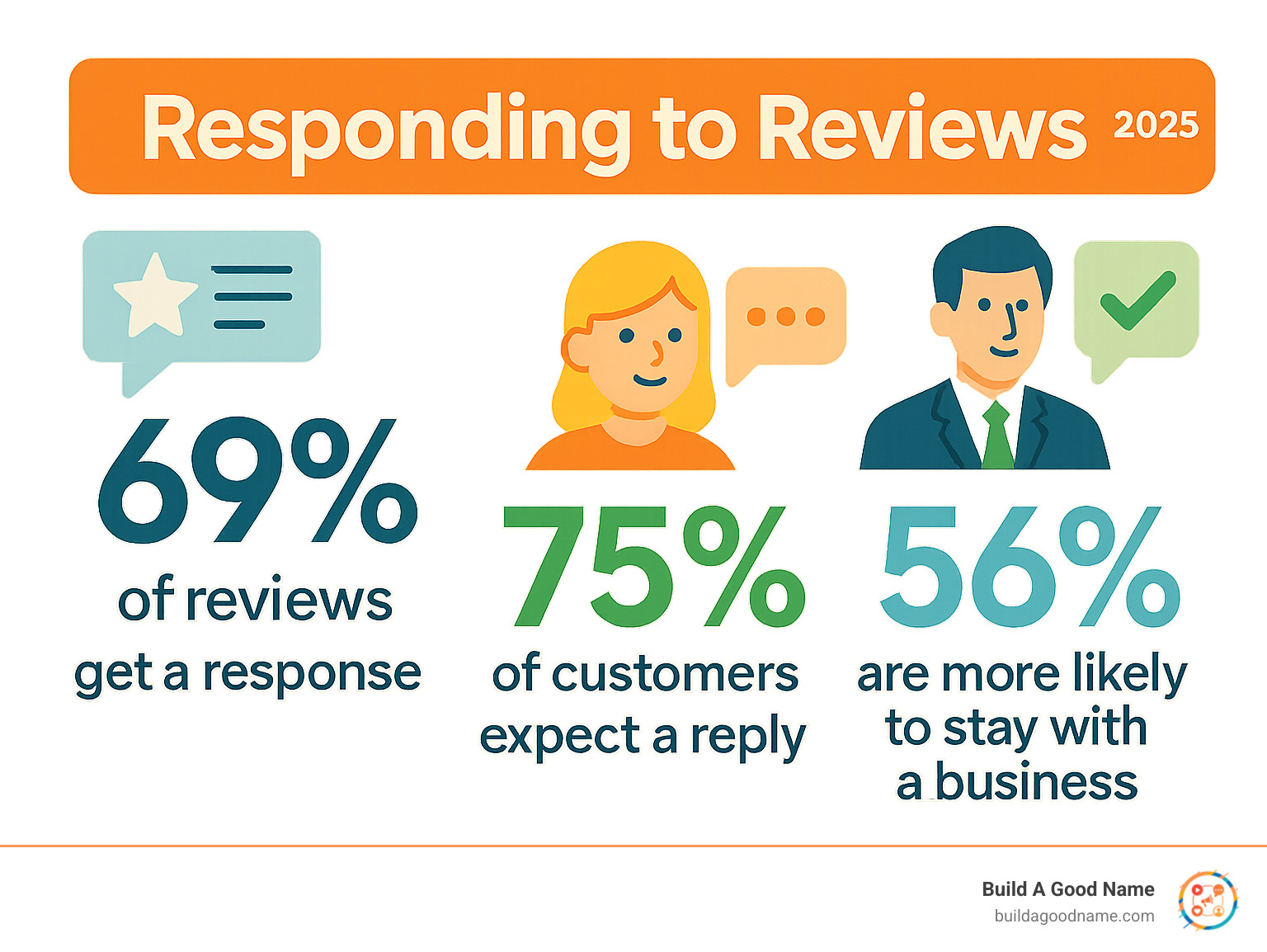Why Your Review Can Make or Break a Business
Learning how to write a good review is one of the most powerful ways to help businesses thrive while guiding fellow customers toward better decisions. Whether you’re praising exceptional service or providing constructive feedback, your words carry real weight in today’s digital marketplace.
Quick Guide to Writing Effective Reviews:
- Be specific – Mention exact products, services, or staff members
- Stay honest – Include both positives and areas for improvement
- Add context – Explain your situation and expectations
- Use photos – Show what you experienced visually
- Keep it helpful – Write 100-300 words that guide future customers
- Proofread – Check for errors and remove personal information
The numbers tell the story: 95% of customers read online reviews before making purchasing decisions, and 88% trust them as much as personal recommendations. Your thoughtful review doesn’t just help other shoppers – it directly impacts whether small businesses succeed or struggle.
The best reviews paint a complete picture. They describe specific experiences, explain what worked (and what didn’t), and offer enough detail for readers to decide if this business fits their needs.

Why Reviews Matter in 2025
Think about the last time you tried a new restaurant or hired a service provider. Chances are, you checked online reviews first. You’re not alone – 68% of customers check online reviews before buying from a local business, and 72% of customers won’t take action until they’ve read what others have to say.
50% of customers trust reviews as much as recommendations from friends and family. That’s remarkable when you consider we’re giving equal weight to detailed reviews from strangers and advice from people we know personally.
Reviews aren’t just about convincing customers anymore. They’re crucial for how search engines decide which businesses to show people. Companies appearing in Google’s Local Map Pack see up to 35% higher click-through rates. Scientific research on social proof confirms that review signals play a significant role in search rankings.
For businesses, reviews work like a Swiss Army knife – they serve multiple purposes at once. They build credibility with potential customers, provide fresh content that improves search visibility, and when you respond thoughtfully, they show customers you value feedback.
Most importantly, reviews give you operational insights that are pure gold. Patterns in customer feedback reveal exactly what’s working well and what needs attention.
A Harvard Business School study found that businesses responding to reviews correlate with higher overall star ratings. 63% of reviews now receive responses from businesses – a 10% increase from the previous year.
Understanding how to write a good review isn’t just helpful for customers – it’s valuable knowledge for business owners too. When you know what makes reviews truly useful, you can better encourage quality feedback and respond more effectively.
How to Write a Good Review: Core Elements
Writing a review that actually helps people isn’t as simple as slapping five stars on something and calling it “amazing.” The most useful reviews share common elements that make them stand out from generic feedback.
The foundation of knowing how to write a good review starts with specificity over generalities. Instead of writing “Great food!” try “The mushroom ravioli had perfectly balanced flavors with a creamy sage sauce that wasn’t too heavy.” One helps you decide if you’d enjoy the dish, while the other tells you almost nothing.
Honest balance separates helpful reviews from promotional fluff. Even five-star experiences usually have room for improvement, and mentioning small areas for growth actually makes your praise more believable.
Your personal context matters more than you might think. Are you a first-time visitor or regular customer? Was this for a special occasion? These details help readers figure out if your experience matches what theirs might be.
Visual evidence through photos provides instant credibility. When you show what you experienced, readers can judge for themselves whether it meets their standards.
Staff recognition when someone goes above and beyond builds personal connections and helps businesses recognize excellent service.
The sweet spot for length hits 100-300 words – enough to be comprehensive without losing your reader’s attention. Most importantly, maintain a constructive tone throughout. Even when sharing criticism, aim to help rather than harm.
| Review Type | Purpose | Length | Focus |
|---|---|---|---|
| Customer Review | Guide purchasing decisions | 100-300 words | Personal experience, pros/cons |
| Case Study | Demonstrate business success | 500-1500 words | Detailed problem-solution-results |
| Testimonial | Provide social proof | 50-150 words | Positive outcomes, recommendations |
Structure That Shines
Great reviews follow a logical flow. Your opening hook should grab attention with either your overall impression or a standout detail. Follow with a brief summary that gives readers the key takeaway in one sentence.
Organize your main thoughts into 2-3 focused body paragraphs covering different aspects of the experience. End with a closing recommendation that offers clear guidance for future customers.
Make sure your star alignment matches your written review. A glowing review paired with three stars confuses readers and undermines your credibility.
Be Detailed & Specific
Vague reviews help no one. Product and service names matter. Write “The signature breakfast burrito” instead of “the food.” Be specific about timeframes – “Delivered in 2 days” beats “fast shipping.”
Share measurable outcomes when possible. Use sensory details that help readers imagine the experience. Point out unique features that set this business apart.
Keep It Authentic & Trustworthy
Only write from first-hand experience. Balance your critique thoughtfully. Use respectful language throughout your review. Proofread before publishing and remove personal information like phone numbers or addresses.
Step-by-Step Guide: How to Write a Good Review for Any Industry
Ready to turn your experience into a review that actually helps people? This how to write a good review process works whether you’re sharing thoughts about your morning coffee spot, a new app, or that hotel where the shower had amazing water pressure.

Step 1: Capture the Full Experience
Your review journey starts before you begin typing. The best reviews come from people who pay attention to their entire experience.
Start with your expectations. What brought you to this business? This context helps readers understand where you’re coming from.
Notice the little interactions. Was booking easy or frustrating? Did someone greet you warmly? These details matter because they’re part of what future customers will experience too.
Think about the aftermath. How do you feel hours or days later? Sometimes the real value becomes clear only after reflection.
Pro tip: jot down quick notes right after your experience while everything is still fresh.
Step 2: Highlight Pros and Cons
Even your favorite restaurant probably has one dish that’s just okay. Balanced reviews feel more trustworthy because they acknowledge that nothing is perfect.
Consider the value equation. Did you get what you paid for? Be honest about quality. Notice the ease factor. Suggest improvements kindly using phrases like “It would be even better if…”
Step 3: Add Supporting Visuals
A photo of your actual meal beats a thousand words. Visual proof makes your review instantly more credible and helps readers know what to expect.
Take photos that tell the story. Show the product, atmosphere, or result. Skip heavily filtered shots – people want to see reality. Capture videos when they add value. Use screenshots for digital services.
The key is taking these visuals during your experience, not trying to recreate them later.
Step 4: Optimize for Helpfulness
Think about future customers who are in the same position you were before trying this business. Keep your length in the sweet spot around 150-300 words. Use words people actually search for. Break up longer thoughts with natural paragraph breaks. Write like you’re talking to a friend.
Step 5: Publish & Engage
Choose your platform thoughtfully. Google Reviews reach the most people, but industry-specific sites might be more relevant. Respond when the business replies. Update if things change. Share your review if you had a particularly strong experience.
For businesses wondering how to handle review conversations professionally, our guide on Best Responses to Google Reviews shows you how to engage with customers in ways that build trust.
Common Mistakes to Avoid When Writing Reviews
Writing a helpful review seems straightforward, but many well-meaning customers accidentally sabotage their own credibility. Understanding these common pitfalls can help you craft reviews that actually guide other shoppers and support businesses.
Vague praise tops the list of unhelpful review habits. Comments like “Amazing!” or “Great service!” might feel good to write, but they tell future customers nothing useful. What specifically impressed you? The devil is in the details when you’re learning how to write a good review.
Exaggeration is another credibility killer. Claiming you found “the best pizza in the universe” immediately raises red flags. Instead, try “the best pizza I’ve had in downtown Springfield” – it’s specific, believable, and still enthusiastic.
Many reviewers accidentally include spoilers without thinking. If you’re reviewing a book, movie, or escape room, keep plot points to yourself. Focus on the quality of the experience rather than revealing what happens.
Unverified claims damage both your credibility and the business’s reputation. Don’t make statements about things you didn’t personally witness. Duplicate text across multiple platforms looks suspicious. Personal information should never appear in reviews.
Emotional venting rarely helps anyone. Reviews written in anger often miss the mark entirely. Take time to cool down and think through what actually went wrong before writing.
For businesses dealing with challenging reviews, our Respond to Google Reviews guide offers strategies for professional responses.
How to Provide Constructive Feedback, Even in Positive Reviews
The most valuable reviews help businesses improve while guiding future customers toward better decisions.
Actionable suggestions work much better than vague complaints. Instead of “service was slow,” try “having a second cashier during lunch rush would help reduce wait times.” This gives the business a specific solution to consider.
Empathy makes your feedback more likely to be well-received. Acknowledge the challenges businesses face. Future-focused comments frame suggestions as opportunities rather than criticisms.
Templates, Phrases & Real-World Examples
Sometimes the hardest part of how to write a good review is simply knowing where to begin. That blank text box can feel intimidating, especially when you want to be helpful but aren’t sure what details matter most.

Restaurant experiences work best when you paint a picture of the entire visit. Start with the occasion, mention specific dishes by name, and describe memorable flavors. Don’t forget servers who went above and beyond.
Software and app reviews need different details. Focus on the problem you were solving and how long it took to see results. Compare the learning curve to similar tools.
Healthcare reviews require extra sensitivity while being informative. Highlight aspects of care that stood out – thorough explanations, minimal wait times, or comfortable staff interactions.
Travel reviews shine when they help others picture their potential experience. Describe location advantages for specific activities and mention amenities that exceeded expectations.
5-Star Review Blueprint
The strongest positive reviews follow a natural emotional arc that feels genuine.
Start with genuine appreciation for the business or specific team members. Highlight what impressed you most – the unexpected upgrade, creative solution, or attention to detail. Explain the personal impact this experience had on you. Close with a clear recommendation that guides future customers.
Snapshot Review: Concise Yet Informative
Not every review needs to be a novel. The three-sentence approach works beautifully for busy readers. Your first sentence should capture your overall impression plus one memorable detail. The second explains what benefit you gained. The final sentence gives a clear recommendation.
Staying under 150 words forces you to focus on what matters most while providing enough information to be helpful.
Mentioning Staff, Locations & Features
Using staff names whenever possible shows you actually visited and creates accountability. Describing how interactions made you feel matters more than just listing what happened. Mentioning specific locations helps businesses understand performance differences.
For businesses wondering how to respond when customers mention staff by name, our 5-Star Review Reply Example guide shows how to acknowledge these personal touches professionally.
Leveraging Your Reviews for Greater Impact
Your thoughtful review doesn’t have to live in isolation on a single platform. Smart customers and businesses know that how to write a good review includes thinking about its broader impact and reach.
When you write a particularly insightful review, consider sharing it with your social network. Your friends trust your judgment, and they’ll appreciate honest recommendations.
Timing matters tremendously when it comes to review requests. The sweet spot is immediately after a positive experience, when emotions are fresh and details are clear.
For businesses looking to systematically improve their review collection and management, explore our Review Management for Local Businesses solutions.
Handling Negative or Mixed Feedback
Not every experience deserves five stars, and that’s perfectly okay. Honest reviews about problems can be the most helpful of all – they set realistic expectations and often lead to improvements.
If you’ve had a disappointing experience, consider reaching out to the business directly before posting your review. Many companies will go above and beyond to make things right. Give them a chance to turn your negative experience into a positive one.
When businesses respond professionally to your concerns and actually fix the problem, don’t forget to update your review accordingly. This shows other customers that the business cares about feedback.
Best Practices for Businesses Responding to Reviews
When you’re on the receiving end of reviews, your response strategy can make or break customer relationships. Thank every reviewer, even those who share critical feedback.
Personalize each response by using the reviewer’s name and referencing specific details. For complex issues, provide contact information to continue the conversation privately. Monitor patterns in your reviews to identify systematic issues that need attention.

Every review response is visible to future customers. Professional, thoughtful replies show prospects how you handle both praise and criticism.
Frequently Asked Questions about How to Write a Good Review
What information should every good review include?
The most helpful reviews tell a complete story that guides future customers toward the right decision.
Start with the basics: What exactly did you buy or experience? Skip vague terms like “the food” and get specific with “the bacon cheeseburger with sweet potato fries.”
Share your context so others can relate to your situation. Were you a first-time visitor? Celebrating a special occasion? Working within a tight budget?
Balance is everything when learning how to write a good review. Even five-star experiences usually have minor areas for improvement, and disappointing visits often have some redeeming qualities.
Include timing details because businesses change over time. Add comparison points when possible – “Better than the chain restaurant down the street” gives readers valuable context.
How long should a helpful review be?
Most people want enough detail to make informed decisions without reading a novel. The sweet spot is 100-300 words – long enough to be genuinely helpful, short enough to hold busy readers’ attention.
Context matters more than word count. A simple coffee shop visit might only need 50-150 words, while complex software purchases could warrant 200-400 words to explain features and comparisons.
The key is saying what needs to be said without unnecessary fluff.
Which platforms make reviews most visible?
Google dominates the review landscape with over 91% of online searches and hosting 71% of all customer reviews. Google reviews appear prominently in search results and map listings.
Facebook comes in second as the next-largest review platform, especially valuable for local businesses with active social media presence.
Industry-specific platforms often provide the most targeted visibility. Restaurant reviews get noticed on Yelp, travelers rely on TripAdvisor, and product reviews on Amazon influence millions of purchasing decisions.
The smartest approach is posting where your target audience naturally looks for information about that type of business.
Conclusion
Mastering how to write a good review transforms you from a passive consumer into an active contributor to your community’s marketplace. Your thoughtful words ripple outward, helping businesses grow and guiding neighbors toward better choices.
The magic happens when you move beyond “Great service!” to paint a complete picture. When you mention Sarah’s warm greeting, describe how the mushroom ravioli tasted, or explain why the software saved you three hours each week, you’re creating something genuinely valuable.
The essential ingredients never change: be specific about what you experienced, stay honest about both highs and lows, provide context about your situation, snap a few photos, and always keep future customers in mind.
For businesses reading this, every review is a conversation starter. Each piece of feedback gives you a chance to show how much you value your customers’ experiences.
At Build A Good Name, we’ve seen how powerful this feedback loop becomes when businesses accept it fully. Our AI-powered review management tools help local businesses turn customer voices into their strongest marketing asset. From crafting personalized responses that feel genuinely human to highlighting your best feedback where it counts most, we handle the heavy lifting so you can focus on what you do best.
The review ecosystem works best when everyone participates thoughtfully. When customers share detailed, honest experiences and businesses respond with genuine care, we all win.
Ready to transform how your business handles reviews? Explore our comprehensive Reputation Management Tools and find how we can help your customer feedback work harder for your success.
Every review you write is a small act of community building. You’re helping a stranger make a better decision, encouraging a business to keep improving, or guiding someone away from a poor fit. That’s the real power of thoughtful feedback – it makes commerce more human, one honest review at a time.



